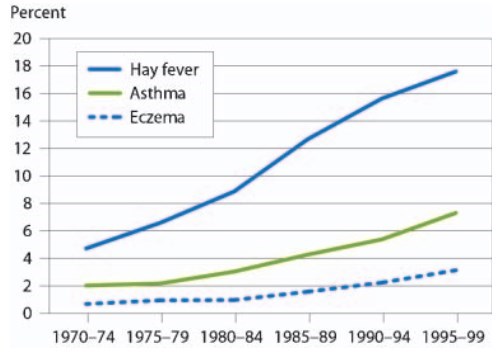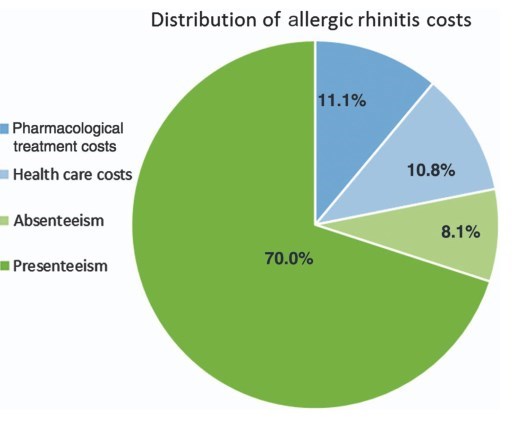Hay fever (Allergic Rhinitis) and Vitamin D - many studies
For productivity to be significantly affected, all of the following must be true
Many people have the problem during their years of employment
Each person has the problem for many days per year
Having the problem reduces productivity while of working age
Hay Fever meets all of those criteria and is reduced by Vitamin D
Other problems meeting the criteria that are reduced by Vitamin D include:

Inhaled nanoemulsion Vitamin D may fight hay fever - Aug 2025
Total Nasal Symptom Score dropped from 11 to 3 after taking Vitamin D - Nov 2024
The Impact of Vitamin-D Supplementation on Individuals with Allergic Rhinitis
Indian Journal of Otolaryngology and Head & Neck Surgery
Stuti Shukla, Sanjeev Kumar Awasthi, Pooja Bhati & Sama Rizvi
Introduction
Allergic rhinitis is a common disease affecting 10 percent people. Sleep, quality of life, and productivity at work are all significantly impacted by severe allergic rhinitis. An increase in allergic diseases has been associated with a lack of vitamin D.
Methods
It is a case control study in which all patients with allergic rhinitis were included and their vitamin d levels were evaluated. Case group was given vitamin d supplementation weekly and their TNSS score was evaluated against those control group where no supplementation was given.
Results
A total of 80 individuals were diagnosed with Allergic Rhinitis. At the time of presentation, the average age of the people was 24.5 years. The average TNSS value before therapy for the study group that took oral vitamin D3 medicine was 11.10 ± 2.10, and after treatment it dropped to 3.2 ± 0.5. The average TNSS score before to therapy was 12.40 ± 2.50 in the control group, which utilised medicines devoid of oral vitamin D3.
Discussion
The link between low vitamin D levels and an increased incidence of allergic disorders has recently attracted more attention on a worldwide scale. But studies on this area have shown contradictory results. The purpose of this study was to determine whether or not supplementing with vitamin D3 helped individuals suffering from allergic rhinitis.
Conclusion
Vitamin D3 significantly improves the clinical manifestations of allergic rhinitis when administered. Noticeable clinical benefits are achieved when the therapy method for allergic rhinitis is changed by injecting vitamin D3
TNSS description by AI
The Total Nasal Symptom Score (TNSS) is a widely used clinical tool for evaluating nasal symptoms in allergic rhinitis, including hay fever. It measures four key nasal symptoms: congestion, sneezing, nasal itching, and rhinorrhea (runny nose)
Each symptom is rated on a four-point scale (0-3):
0: No symptoms
1: Mild symptoms (easily tolerated)
2: Moderate symptoms (bothersome but tolerable)
3: Severe symptoms (hard to tolerate, interfering with daily activities)
The individual symptom scores are summed to create a
total score out of 12, with higher scores indicating more severe symptoms
📄 Download the PDF from VitaminDWiki
China planted 74 million acres of highly pollinated trees, significantly increasing Hay Fever - May 2025
Bloomberg paywall
"Willows and poplar trees, both widely planted in the north, have high pollen output that sweeps across northern Chinese cities every spring, causing allergic reactions among residents. "
It replaced the desert dust with forest pollen
"While its overall prevalence among adults in China is about 18%, in Yulin, a city in the region where the forestation project is carried out, 27% suffer from hay fever. In Inner Mongolia, the rate is 32%."
"So to deal with the pollen that plagues cities for weeks every spring, authorities are hosing down sidewalks in densely populated areas and spraying plant hormones on female trees to suppress growth of flower buds. And Beijing issues alerts to let hay fever sufferers know how long the peak pollen is expected to last and what times of day the levels are particularly high. "
Japan Tackles Productivity Losses From Its Pollen-Rich Trees - April 2024
40% of workers and students were affected in 2019, but only 20% in 2004
The economic losses are sizable: about $1.5 billion every day
Pollen season in Japan lasts from Feb thru April
VitaminDWiki suspects that there is not 2X more pollen now,
but rather that Vitamin D levels have been crashing
14+ VitaminDWiki pages have "HAY FEVER" or "ALLERGIC RHINITIS" in the title
This list is automatically updated
{LIST()}
TOTALL: high cost of allergic rhinitis—a national Swedish population-based questionnaire study – Feb 2016
📄 Download the PDF from VitaminDWiki

Abstract Allergic rhinitis is a global illness with a well-recognised impact on quality of life and work performance. Comparatively little is known about the extent of its economic impact on society. The TOTALL study estimates the total cost of allergic rhinitis using a sample representing the entire Swedish population of working age. A questionnaire focused on allergic rhinitis was mailed out to a random population of Swedish residents, aged 18–65 years. Health-care contacts, medications, absenteeism (absence from work) and presenteeism (reduced working capacity at work) were assessed, and the direct and indirect costs of allergic rhinitis were calculated. Medication use was evaluated in relation to the ARIA guidelines. In all, 3,501 of 8,001 (44%) answered the questionnaire, and 855 (24%) of these reported allergic rhinitis. The mean annual direct and indirect costs because of allergic rhinitis were €210.3 and €750.8, respectively, resulting in a total cost of €961.1 per individual/year. Presenteeism represented 70% of the total cost. Antihistamines appear to be used in excess in relation to topical steroids, and the use of nasal decongestants was alarmingly high.
The total cost of allergic rhinitis in Sweden, with a population of 9.5 million, was estimated at €1.3 billion annually. These unexpectedly high costs could be related to the high prevalence of disease, in combination with the previously often underestimated indirect costs. Improved adherence to guidelines might ease the economic burden on society.
Editorial Summary: Allergies: Hay fever costly to Swedish society
Allergic rhinitis, commonly known as hay fever, costs Swedish society €1.3 billion annually. Johan Hellgren and colleagues from the Swedish Rhinologic Research Alliance and the Swedish Institute for Health Economy sent questionnaires to a random population of Swedish residents aged 18-65 years. Nearly a quarter of the 3,501 responders were found to suffer from allergic rhinitis. The team calculated the direct and indirect costs of allergic rhinitis by assessing health-care contacts, medications, absence from work and reduced capacity while working. The total annual cost of the disease was estimated at €961 per person affected. Working while incapacitated by the condition represented 70% of the total cost . The use of nasal decongestant and steroid spray was similar (~40%). The team says improved adherence to treatment guidelines may ease the economic burden of the disease.
Nasal Allergies: More Than a Nuisance US News March 2019
“of 100 patients who had moderate to severe symptoms of hay fever, 66 percent of adults and 43 percent of children reported sleep disturbances”
“Recent research found an estimated 3.6 percent of missed work time (absenteeism) and 35.9 percent of work performance problems (presenteeism) resulted from nasal allergies.”
“There has been a great deal of interest in climate change. What's that have to do with spring hay fever? A lot!”
Treating allergic rhinitis through better patient management Medical Economics April 2015
“…50 million Americans suffer from allergic rhinitis, which includes hay fever and seasonal or perennial indoor/outdoor nasal allergies.”
“These conditions are thought to affect up to 30% of adults and 40% of children”
- …in the 1940s, hay fever was estimated to affect only 1% of the U. S. population”
“Hay fever is the fifth-leading chronic disease for adults and a significant cause of work absenteeism,”
“In addition, hay fever results in significant presenteeism, with poor performance while at work due either to the symptoms of the condition itself or the effects of medication used to treat those symptoms.”
“Even with these attempts at treatment, about 50% of patients with allergic rhinitis report symptoms lasting more than four months per year, and 20% have symptoms lasting at least nine months.”
Got Hay Fever? Get to Work! WebMD 2008
“Hay fever is the fifth most common chronic disease”
“"For people with hay fever who get the right medicine and the right dosage, the amount of lost productivity has dropped to almost zero. But if you're not taking medication -- or taking the wrong medication -- there will be lost productivity.”
Poll of people with allergies
43% said that allergies affected their productivity at work.
50% said their ability to concentrate was impaired.
68% had trouble getting a good night's sleep.
